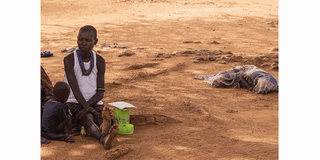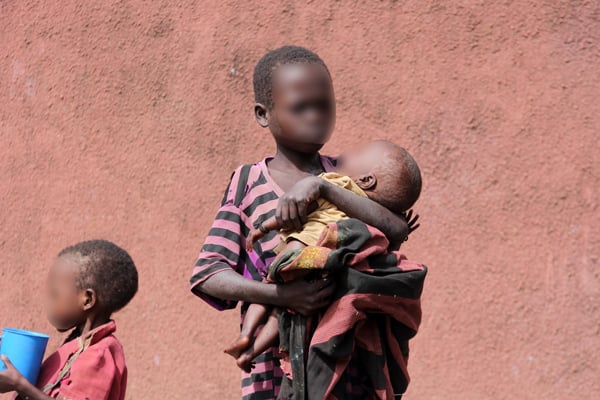Prime
Famine consumes Karamoja

A mother and her children during a nutrition screening at Nadunget Health Centre in Nadunget, Karamoja Sub-region, Uganda, on May 24. In Karamoja and some parts of Lango sub-regions, there are reports of people dying of hunger as a result of food shortage. PHOTO/AFP
What you need to know:
- The most affected districts are Kotido, Napak, Kaabong, and Moroto.
Four in every 10 Karimojong have no food, only two in 10 have stocks enough to last a month, while three percent will be able to feed themselves for the next 90 days, according to the government.
In a brief to Parliament yesterday about the worsening famine situation in Karamoja Sub-region, the State Minister for Disaster Preparedness, Ms Esther Anyakun, said: “517,800 representing 41 per cent of the population have been at risk of food shortage between March and July. Eighty percent will last a month. Only 3 per cent have stocks to last three months or more.”
The most affected districts are Kotido where 1O7, 7OO are estimated to be starving, Napak (81,800), Kaabong (70,600), and Moroto (61,900).
Leaders in the region have described the situation as an emergency, and asked bureaucrats to waive procurement bureaucracies and get food to residents clinging on a string of life.
In the remote Iriri Sub-county in Napak District, our reporter yesterday found 60-year-old Maritina Maruk lying motionless on a mat behind a grass-thatched house. As of yesterday, she said she had spent two days without a meal.
Ms Maruk lives with two grandchildren. The mother of one passed on in May and the father reportedly abandoned the family.
Her seven-year-old grandson busied herself eating fried fermented maize flour ordinarily used to make local brew.
A few metres away, the household of ailing Zackary Lokut last month buried their father who reportedly succumbed after a two-day starvation. Survivors harvest and eat okra-like wild plants, which Mr Lokut said causes diarrhoea and weight loss.
Despite government as well as the Opposition National Unity Platform transporting food to Karamoja this week, the stock has been stored, pending distribution expected to start tomorrow.
On Tuesday, Napak Woman MP Faith Nakut told Parliament that as of July 8, more than 600 starvation-related deaths had been recorded in Kotido, Napak, Moroto, and Kaabong.
“We acknowledge there have been responses by the Office of the Prime Minister, food was distributed in Karamoja, each district settling for 150 tonnes of maize floor and beans targeting the most vulnerable. Unfortunately, the quantities supplied were not reasonable to feed a family for a week,” she said.
The Office of the Prime Minister (OPM) yesterday delivered 400 bags of maize flour and 200 bags of beans to Iriri sub-county, one of the most devastated by famine. “What we received is only for Iriri Sub-county, but I am told that another consignment for Nabwal Sub-county is on the way,” the Iriri Sub-county chairperson, Mr Ben Peter Loburo, said.
A Cabinet sitting on July 10 earmarked Shs135.2b to procure food to be distributed in Karamoja over the next three months.
In Ms Anyakuni’s statement, relief to the sub-region started in April, where 1,590 metric tonnes of maize floor and 795 tonnes of beans have so far been delivered. But questions abide on sufficiency of the quantities as well as the efficiency of the distribution process.
Jie County lawmaker Peter Lokii said despite the reported food aid, more people continue to die daily due to hunger. He cited Kotido where 380 people have reportedly died.
The famine has been attributed to a back-to-back plethora of problems: low crop yields due to locust invasion followed by prolonged drought and floods, Covid-19 disruptions and an explosion of insecurity reportedly fanned by cattle rustlers.
The Napak chairperson, Mr John Kodet, said they expect to start giving out relief food tomorrow.
His vice Joshua Lomonyang, who represents Nabwal Sub-county, claimed that hunger-related diseases have claimed 52 lives in his constituency and Iriri, higher than the 46 that MPs from the region initially estimated.




